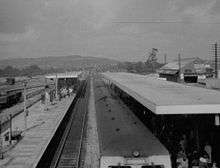Whitland railway station
| Whitland | |
|---|---|
| Welsh: Hendy-gwyn ar Daf | |
 The station as seen from platform one | |
| Location | |
| Place | Whitland |
| Local authority | Carmarthenshire |
| Coordinates | 51°49′05″N 4°36′50″W / 51.818°N 4.614°WCoordinates: 51°49′05″N 4°36′50″W / 51.818°N 4.614°W |
| Grid reference | SN198165 |
| Operations | |
| Station code | WTL |
| Managed by | Transport for Wales |
| Number of platforms | 3 |
| DfT category | F1 |
|
Live arrivals/departures, station information and onward connections from National Rail Enquiries | |
| Annual rail passenger usage* | |
| 2012/13 |
|
| 2013/14 |
|
| 2014/15 |
|
| 2015/16 |
|
| 2016/17 |
|
| History | |
| Original company | South Wales Railway |
| Pre-grouping | Great Western Railway |
| Post-grouping | Great Western Railway |
| 2 January 1854 | SWR station opened |
| 4 September 1866 | P&T station opened |
| August 1869 | P&T station closed |
| National Rail – UK railway stations | |
| * Annual estimated passenger usage based on sales of tickets in stated financial year(s) which end or originate at Whitland from Office of Rail and Road statistics. Methodology may vary year on year. | |
|
| |
Whitland railway station serves the town of Whitland in Carmarthenshire, Wales. It is located on the main route of the West Wales line from Swansea. To the west of the station, a branch line diverges to Pembroke with the main line continuing to Milford Haven and FishguardHarbour. Formerly, the Whitland and Cardigan Railway (closed in 1962) diverged from the Fishguard/Milford Haven line two miles west of Whitland.
Passenger services are operated by Transport for Wales using a mixture of Class 150, Class 153 and Class 175s, and Great Western Railway who run services using InterCity 125 trains on summer Saturdays from London Paddington to Pembroke Dock.
History
The station was opened by the South Wales Railway on 2 January 1854[1] on their route from Cardiff to Haverfordwest, which was extended to Neyland two years later. A branch line to Milford Haven followed in 1863 and the Pembroke and Tenby Railway (P&T) arrived from Tenby in 1866; their route was built as standard gauge, rather than the SWR's broad gauge, and so initially the P&T had to terminate at its own station next to the main line one, which by now was owned by the Great Western Railway. This separate P&T station had opened on 4 September 1866 and was closed in August 1869.[1] A single line was converted to dual gauge in 1868 to allow P&T trains to reach Carmarthen. Full-through-running trains between the two routes was made possible in 1872 with the conversion of the main line to standard gauge. The network in the area was completed when the Cardigan branch was opened in stages between 1873 and 1886.
From 1957 the station was rebuilt. On the up side it had a ticket hall, waiting room with refreshments, ladies waiting room, toilets, stationmaster's office, district inspector's office, parcels office, central heating, and a 320 ft (98 m) steel and aluminium platform canopy. On the down side it had a 270 ft (82 m) canopy, refreshment room and toilets.[2]
Services
The station has an approximately hourly service (including Sundays) to and from Carmarthen and Swansea eastbound and every two hours westbound to each of Milford Haven and Pembroke Dock. Certain eastbound services continue onwards to Cardiff Central, Hereford and Manchester Piccadilly.[3]

The services between Fishguard Harbour and Carmarthen (and stations further afield) also call (4 trains per day Mon-Sat, with 1 on Sundays, plus a 7-days-a-week night time service). Summer Saturday InterCity 125 services between London Paddington and Pembroke Dock also serve Whitland.
Rail and sea corridor to Ireland
Transport for Wales boat trains to and from Fishguard Harbour serve the station. These connect with the Stena Line ferry to Rosslare Europort in Ireland with a daily morning and evening service in both directions. This route has been in existence since 1906.
Facilities
Despite being a once-major junction, the facilities at Whitland station are very poor. There are no toilets, nor a waiting room for passengers awaiting a service along the other line to use to take shelter from the wind. The main building located on the eastbound platform once contained a waiting room and ticket office, but is now closed and boarded up (tickets must therefore be purchased onboard the train or prior to travel). Most of this platform is covered by a canopy, and west of the building rusting rails remain in one of the former bay platforms. Across the footbridge, waiting shelters are provided on the westbound platform. There is in fact a serviceable bay platform behind this, accessed from the Pembroke Dock branch, but this is seldom used for passenger trains as services from the branch do not normally terminate at Whitland.
Train running information is provided by timetable posters, digital display screens and a customer help point on each side. Step-free access is available to both operational platforms, though the eastbound one is via a steep ramp.[4]
References

External links
- Train times and station information for Whitland railway station from National Rail
| Preceding station | Following station | |||
|---|---|---|---|---|
| Carmarthen | Transport for Wales West Wales line - Pembroke branch |
Narberth | ||
| Transport for Wales West Wales line - Milford Haven and Fishguard branches |
Clunderwen | |||
| Carmarthen | Great Western Railway London - Pembroke |
Saundersfoot Or Narberth | ||
| Historical railways | ||||
| St Clears Line open, station closed |
Great Western Railway South Wales Railway |
Clunderwen Line and station open | ||
| Disused railways | ||||
| Terminus | Great Western Railway Whitland and Cardigan Railway |
Llanfalteg Line and station closed | ||
